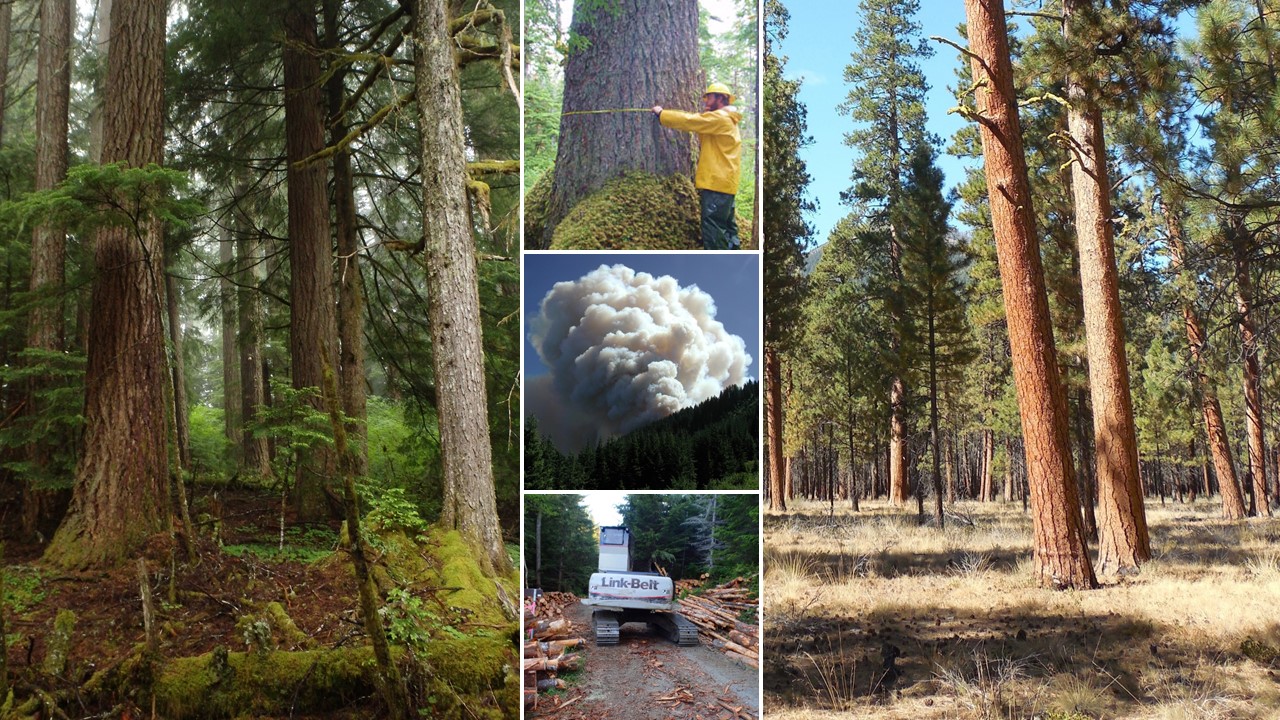Regional Ecosystem Office (REO) - Northwest Forest Plan
Interagency Regional Monitoring:
Late-Sucessional and Old Growth

The Late-Successional/Old-Growth (LSOG) Monitoring Program conducts long-term monitoring of these forest types to determine the effectiveness of federal forest management on maintaining and restoring LSOG forest ecosystems to desired conditions on federal lands. Main objectives are to:
- Track status and trend of amount and distribution of older forests in the Northwest Forest Plan area.
- Determine what are the disturbances and stressors causing change in the amount and distribution of older forest classes.
Our monitoring uses remote sensed data from satellite imagery and analysis and modeling of forest inventory plot data to track annual status and trends of forest structure and species composition. Remote sensed and plot data of forest conditions provides the information needed for tracking losses and gains in older forest conditions from human and natural disturbances, such as timber harvesting, wildfire, and insect and disease.
Contact Information
- Raymond Davis – Program Manager
- Telephone: 541-750-7179
- Email: raymond.davis@usda.gov
- Sean Healey – Co-lead Scientist on Forest Disturbance and Change Detection Mapping
- Telephone: 801-625-5770
- Email: sean.healey@usda.gov
- David Bell – Lead Scientist on Forest Vegetation Structure and Composition Mapping
- Telephone: 541-750-7298
- Email: david.bell@usda.gov
- Andrew Gray – Lead Scientist on Forest Inventory and Analysis using Plot Data
- Telephone: 541-750-7252
- Email: andrew.gray@usda.gov
- Zhiqiang Yang – Lead Scientist for Google Earth Engine Applications
- Telephone: 541-750-7491
- Email: zhiqiang.yang@usda.gov
Reports
| Time | Five-Year Monitoring Reports |
|---|---|
| 25-Year | Davis, Raymond J.; Bell, David M.; Gregory, Matthew J.; Yang, Zhiqiang; Gray, Andrew N.; Healey, Sean P.; Stratton, Andrew E. 2022. Northwest Forest Plan—the first 25 years (1994–2018): status and trends of late-successional and old-growth forests. Gen. Tech. Rep. PNW-GTR-1004. Portland, OR: U.S. Department of Agriculture, Forest Service, Pacific Northwest Research Station. 82 p. |
| 20-Year | Davis, Raymond J.; Ohmann, Janet L.; Kennedy, Robert E.; Cohen, Warren B.; Gregory, Matthew J.; Yang, Zhiqiang; Roberts, Heather M.; Gray, Andrew N.; Spies, Thomas A. 2015. Northwest Forest Plan–the first 20 years (1994-2013): status and trends of late-successional and old-growth forests. Gen. Tech. Rep. PNW-GTR-911. Portland, OR: U.S. Department of Agriculture, Forest Service, Pacific Northwest Research Station. 112 p. |
| 15-Year | Moeur, Melinda; Ohmann, Janet L.; Kennedy, Robert E.; Cohen, Warren B.; Gregory, Matthew J.; Yang, Zhiqiang; Roberts, Heather M.; Spies, Thomas A.; Fiorella, Maria 2011. Northwest Forest Plan–the first 15 years (1994–2008): status and trends of late-successional and old-growth forests. Gen. Tech. Rep. PNW-GTR-853. Portland, OR: U.S. Department of Agriculture, Forest Service, Pacific Northwest Research Station. 48 p. |
| 10-Year | Moeur, Melinda; Spies, Thomas A.; Hemstrom, Miles; Martin, Jon R.; Alegria, James; Browning, Julie; Cissel, John; Cohen, Warren B.; Demeo, Thomas E.; Healey, Sean; Warbington, Ralph. 2005. Northwest Forest Plan—the first 10 years (1994-2003): status and trend of late-successional and old-growth forest. Gen. Tech. Rep. PNW-GTR-646. Portland, OR: U.S. Department of Agriculture, Forest Service, Pacific Northwest Research Station. 142 p. |
| Monitoring Plan | Hemstrom, Miles; Spies, Thomas; Palmer, Craig; Kiester, Ross; Teply, John; McDonald, Phil; Warbington, Ralph. 1998. Late-successional and old-growth forest effectiveness monitoring plan for the Northwest Forest Plan. Gen. Tech. Rep. PNW-GTR-438. Portland, OR: U.S. Department of Agriculture, Forest Service, Pacific Northwest Research Station. 37 p. |
For older reports see the document archive
Data
| Report Details |
|---|
Fire Regimes
|
20-Year Report
|
15-year Report
|